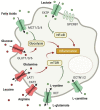Metabolite Transporters as Regulators of Immunity
- PMID: 33086598
- PMCID: PMC7603148
- DOI: 10.3390/metabo10100418
Metabolite Transporters as Regulators of Immunity
Abstract
In the past decade, the rise of immunometabolism has fundamentally reshaped the face of immunology. As the functions and properties of many (immuno)metabolites have now been well described, their exchange among cells and their environment have only recently sparked the interest of immunologists. While many metabolites bind specific receptors to induce signaling cascades, some are actively exchanged between cells to communicate, or induce metabolic reprograming. In this review, we give an overview about how active metabolite transport impacts immune cell function and shapes immunological responses. We present some examples of how specific transporters feed into metabolic pathways and initiate intracellular signaling events in immune cells. In particular, we focus on the role of metabolite transporters in the activation and effector functions of T cells and macrophages, as prototype adaptive and innate immune cell populations.
Keywords: T cells; cell metabolism; immunity; macrophages; metabolite transporter; solute carrier.
Conflict of interest statement
The authors declare no conflict of interest.
Figures


References
-
- Hsu C.-L., Dzhagalov I.L. Metabolite Transporters—The Gatekeepers for T Cell Metabolism. Immunometabolism. 2019 doi: 10.20900/immunometab20190012. - DOI
Publication types
LinkOut - more resources
Full Text Sources
Research Materials
Miscellaneous

